Resonance is an odd duck in the watch world. Many people believe resonance to be very rare, when in fact every single timekeeping device (yes, even quartz) is a resonant mechanism.
Resonance is not rare; it is the most common thing in watches that keep time with an oscillator. From a G-Shock to a Patek Philippe super complication, from a Seiko 5 to a Greubel Forsey Invention Piece, all watches are resonance watches.
Now that I’ve made an objectively true statement that people may want to disagree with (you can’t, it’s a fact), let’s move on to the nuances and discuss resonance in the way that most people actually mean when they refer to a resonance watch.
“Resonance is the tendency of a mechanical system to respond at greater amplitude when the frequency of its oscillations matches the system’s natural frequency of vibration.”
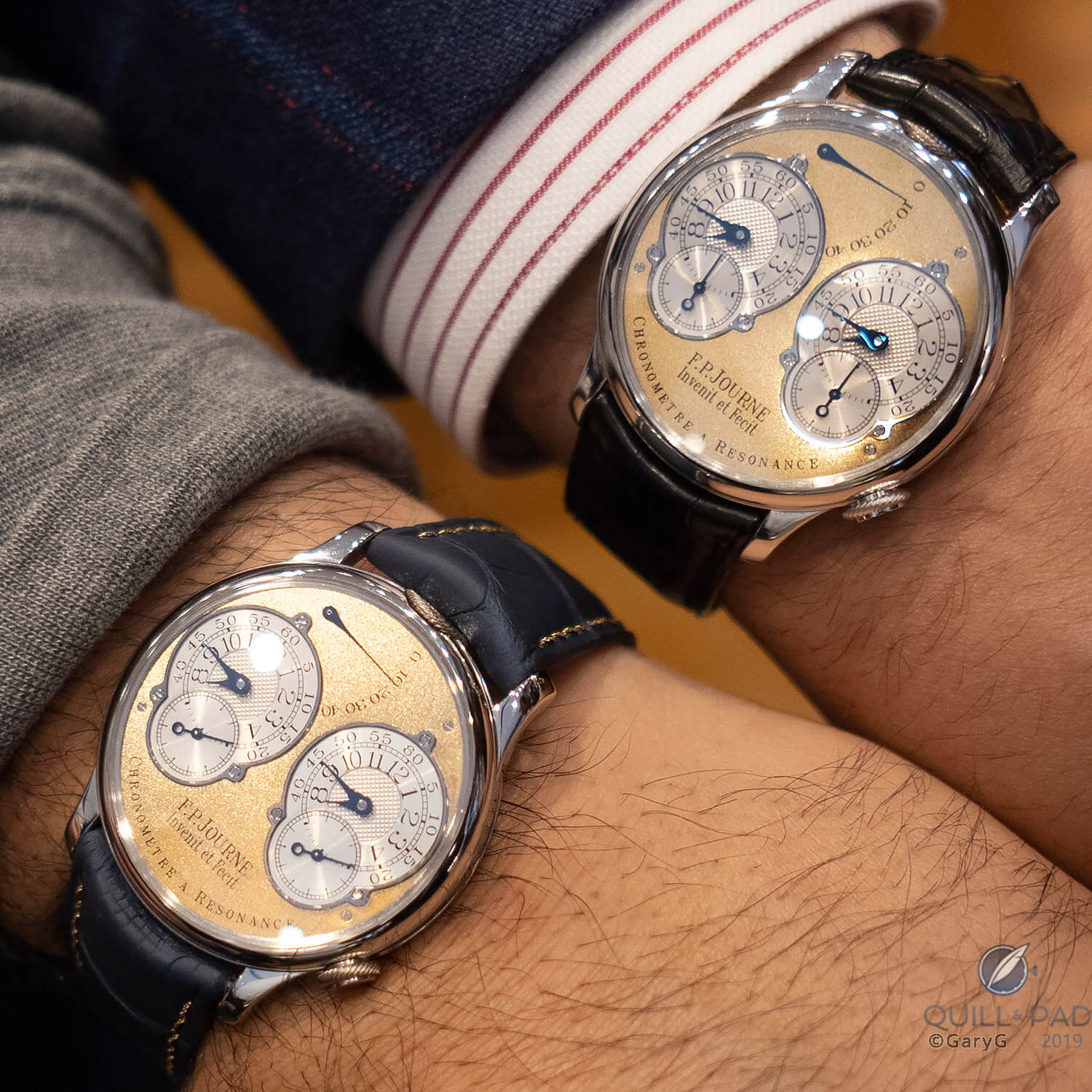
Two early brass-movement F.P. Journe Chronomètre à Résonance models
In simple terms, this means any oscillator – such as a balance wheel – will find its natural frequency (which is what we refer to when we state a watch’s frequency in Hertz/Hz/vph/bph) when external force is applied (in this case via the escapement pallets).
Resonance is basically finding the sweet spot where a small input at the precisely right moment can create a large and stable oscillation – like pushing your friend on a swing at the right time.
Even though resonance underpins lots of things in physics, we don’t need to delve too deeply into the weeds, but simply focus on how it relates to watches and the rare category of today’s resonance watches that highlight the phenomenon in specific ways.
This is where we come back to why resonance is a bit of an odd duck. It was historically used as both an experiment in creating self-correcting mechanisms and a test of precision capabilities, mostly to learn if the phenomenon could be harnessed to make significant gains in isochronism i.e., consistency of the beat rate.
Early in the days of horological giants like Abraham-Louis Breguet and Antide Janvier, advancements were coming fast in the world of precision timekeeping. New ways of creating balance springs, mainsprings, adjustments to tooth geometry, development of constant force mechanisms, and the invention of the tourbillon were all experiments in the service of creating hyper-precise (for the time) clocks and watches that could advance scientific research and solve the problem of determining longitude at sea.
Any idea was worth trying, and one promising idea was the phenomenon of resonance.
Early experiments in resonance
Horologists were familiar with the concept of resonance because it is how all watches and clocks function on a basic level. But happy discoveries and purposeful research into linked (synchronized) timekeepers showed advantages for self-correcting and stabilizing timekeepers.
As mentioned in the article by Justin Koullapis, A Watchmaker’s Technical Look At The Mirrored Force Resonance Fire By Armin Strom: A Dual-Balance Watch With A Difference, which takes a technical look into resonance and its horological application, there were some early findings by Abraham-Louis Breguet uncovering unique peculiarities about the phenomenon.
Koullapis discussed that Breguet made a set of pendulum clocks attached to a shared rigid frame that, when adjusted very accurately, would synchronize and self-correct each other from minor disturbances. But the ability to synchronize was a factor of how closely each pendulum was tuned to the other and the rigidity of the structure that they were both mounted to.
Further experiments showed that a lightweight frame (read: flexible) could help the pendulums synchronize more easily when they were much less finely tuned. In the most rigid scenario, the pendulums would need to be within three seconds of each other’s rate to synchronize, but with a flexible frame the pendulums only need be within a 21-second average of each other.
The downside was that while relatively flexible frames were much easier to synchronize, the instability of the frame did not create stable rates in the clocks; the system was too loose. That is obviously a huge problem for pendulum clocks, which need very strong frames to work properly. In bringing the idea into watches it would mean that any gains from synchronization would be lost to inaccuracies from instability.
So Breguet did what any good instrument maker would do: he opted for the much more rigid design and built that into a few resonance watches. Thus the idea was born that synchronized resonance watches, and clocks, needed very precise and rigid movements with twin oscillators adjusted to within a very small margin. This made perfect sense for the time, but it also proved to be the death blow to the concept on the larger scene.
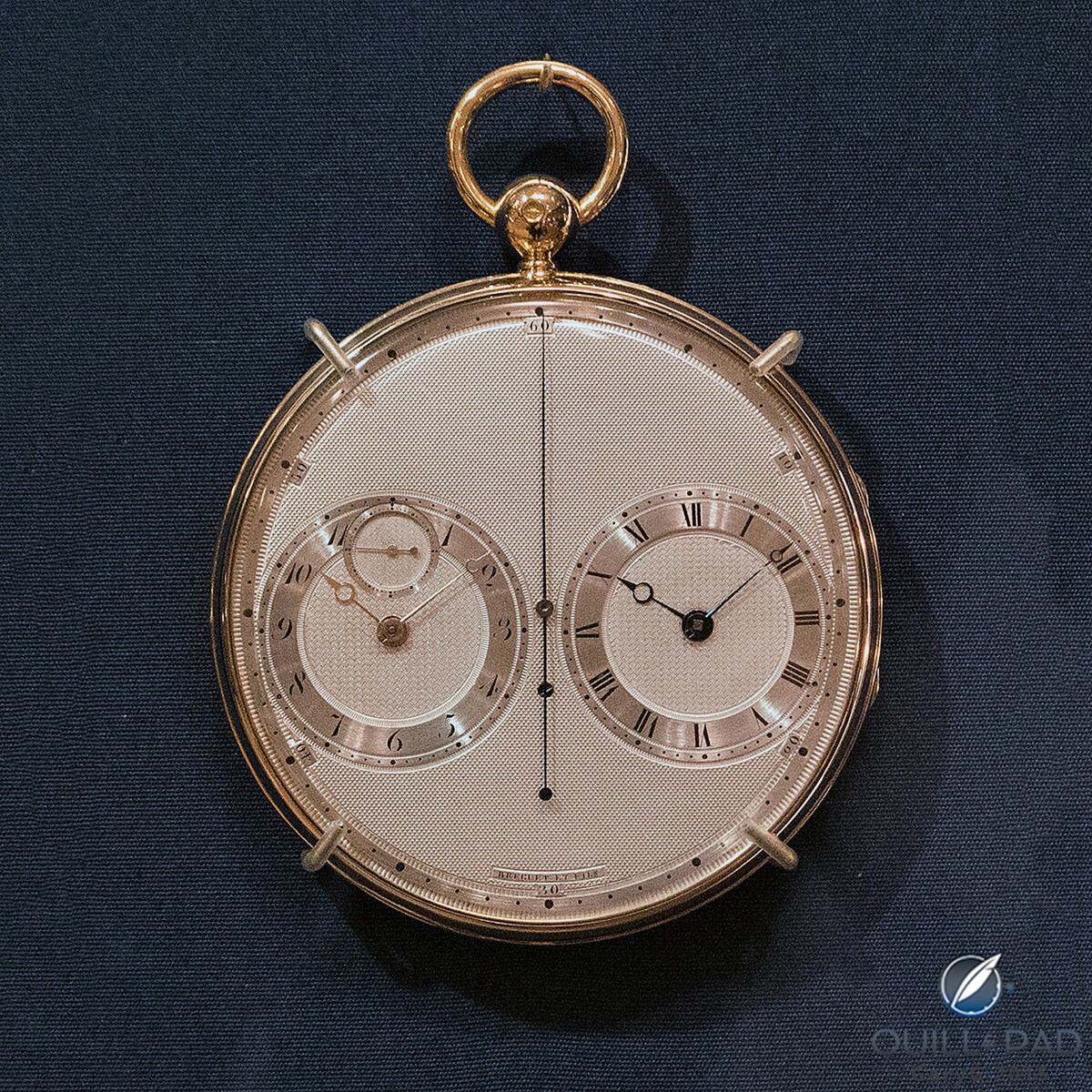
Breguet resonance pocket watch circa 1814
Resonance watches with twin movements and oscillators adjusted very precisely did not provide much, if any, justifiable improvement over the tourbillon mechanism, watches fitted with a remontoir d’égalité constant force mechanism, or chronometer watches utilizing a detent escapement.
While all these mechanisms were difficult to produce, only one of them required two complete movements mounted in one watch. No need to guess which ideas became more popular and which one largely stayed a novelty.
Modern-day resonance: only three production wristwatches
The examples of clocks and watches featuring this type of resonance phenomenon throughout the last two centuries are few and far between, ensuring that any example is both highly coveted and generally rare.
In the last few decades, less than a handful of highly skilled watchmakers have taken up the challenge of creating a resonance watch. Actually, the number is likely unknown (there can always be independent watchmakers who don’t get exposure), but only three production wristwatches have featured resonance to my knowledge (I’m include treating of the varieties of the Armin Strom Mirrored Force Resonance as one example).

Resonance trio: Armin Strom Mirrored Force Resonance, Beat Haldimann H2 Flying Resonance, and F.P. Journe Chronomètre à Résonance
The F.P. Journe Chronomètre à Résonance, the Haldimann H2 Flying Resonance, and the Armin Strom Mirrored Force Resonance use different methods to create their respective resonance with the F.P. Journe version, which came first, taking the original Breguet route.
The F.P. Journe Chronomètre à Résonance, debuting in 2000, utilizes highly constrained balances mounted to within a couple tenths (0.01) of a millimeter from each other and adjusted to within a five-second per day average. The design of the main plate, the proximity, and the precise adjustment, allows a small amount of energy from each balance to transfer through the movement into the opposite balance.
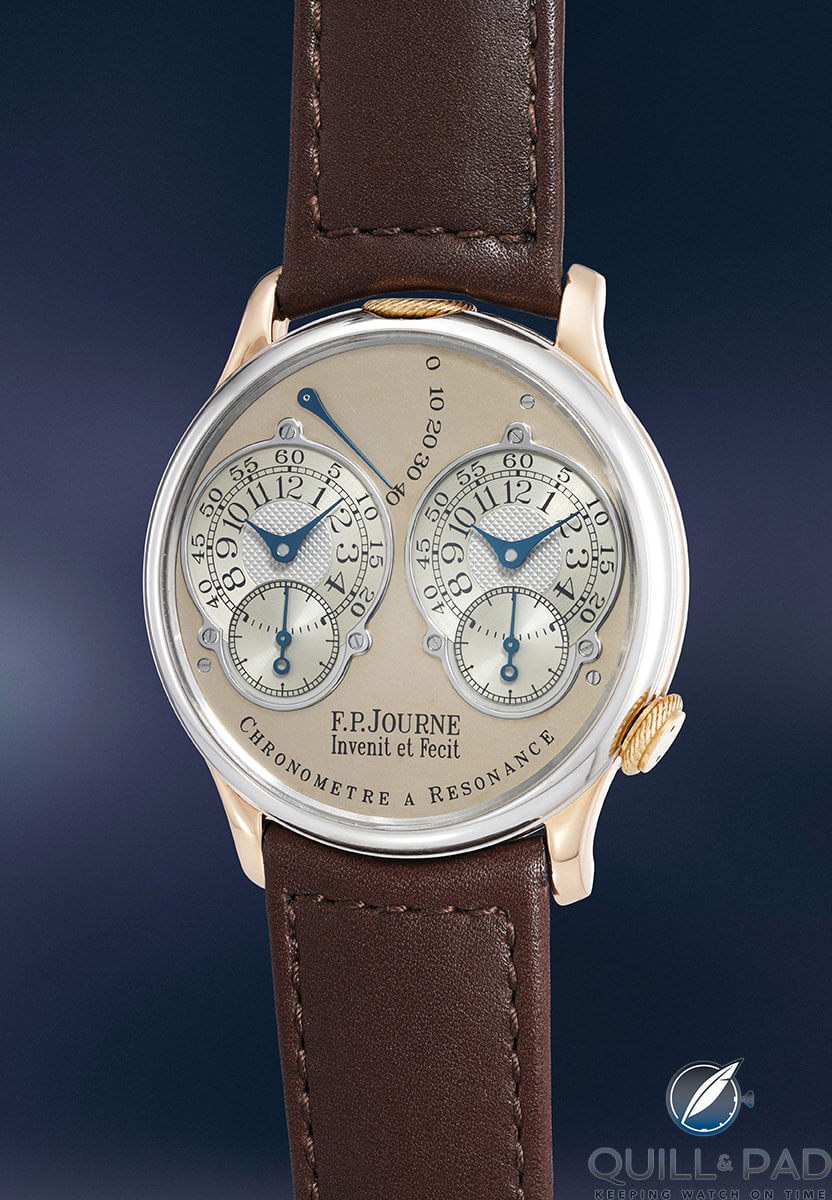
One of the first 20 F.P. Journe Chronomètre à Résonance Souscription pieces (photo courtesy Phillips)
Since they are nearly on the exact same frequency, the small amount of vibrational energy transferring between the two oscillators gradually tugs on each balance to bring them into synchronization. This energy transfers via a vibration wave through the movement, which is why the proximity was minimized as much as possible and any features that would dampen this effect were altered or moved. The hairsprings needed to be free sprung as well to avoid any extra components and gaps that could stop the small amount of energy transfer.
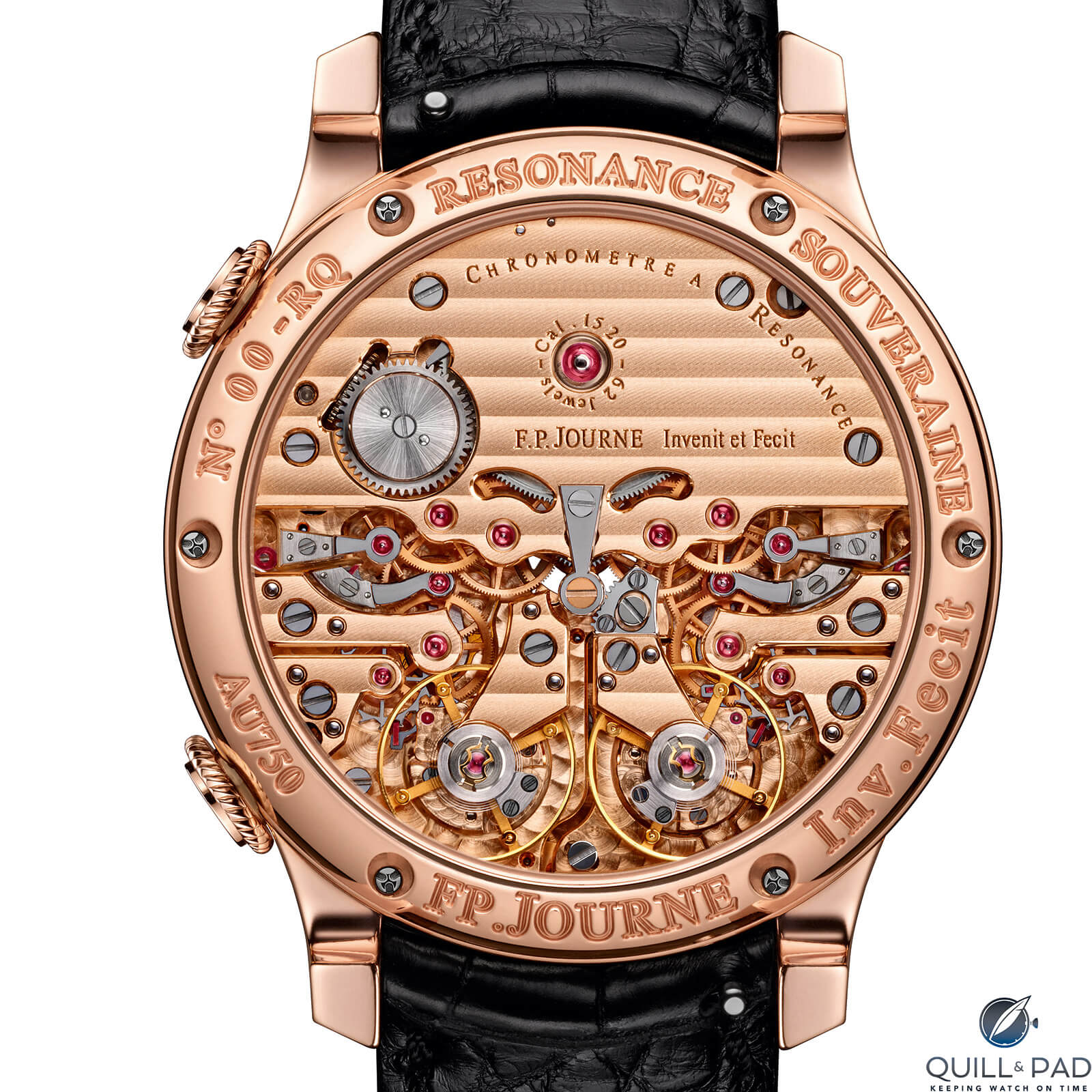
Back of the F.P. Journe Chronomètre à Résonance 20th Anniversary in 6N red gold
It’s a great system, but very touchy to set up and requiring a very solid movement architecture to achieve good results. This system also has such a narrow window of operation that it is much less friendly to heavy shocks or disturbances of the movement.
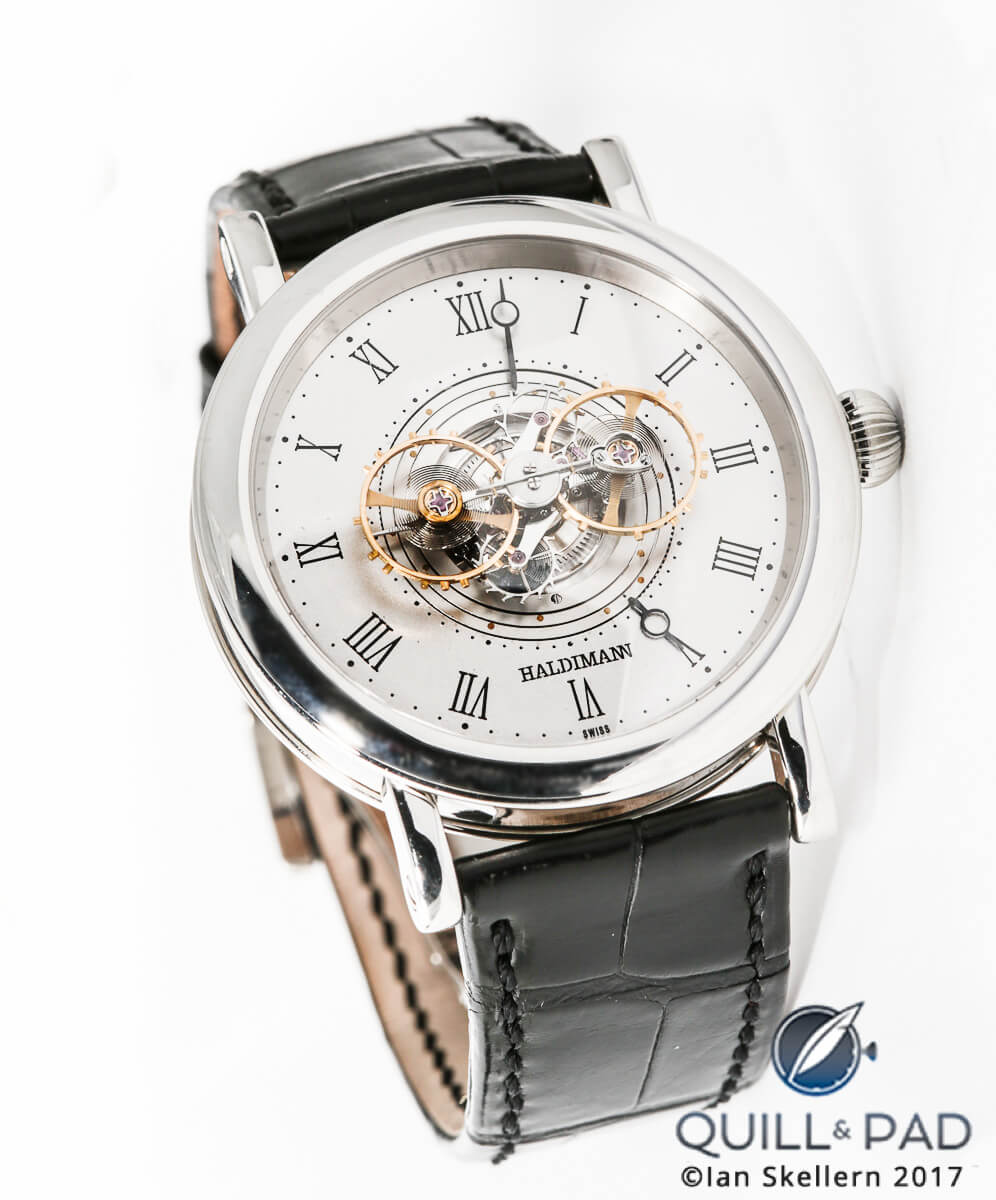
Beat Haldimann H2 Flying Resonance
Beat Haldimann’s H2 Flying Resonance, introduced in 2005, takes a page out of Breguet’s playbook as well but not his final design. The H2 Flying Resonance took the lessons that Breguet learned and applied them in a similar way to pendulum clocks. The H2 links the hairspring studs with a blade-style bridge named the resonance coupling spring, physically joining the two with a semi-rigid structure.
Instead of relying on tiny vibrations to travel all the way through a balance cock, main plate, second balance cock and mounting stud, H2 shortens that path as much as possible. This ensures that the vibrations can travel directly from one oscillator to the other, making the transmission of energy more efficient as if the two oscillators were pendulums mounted to the same frame.
It’s also the only way to feasibly achieve this phenomenon since flying tourbillons are the opposite of rigidly mounted, and the tourbillon carriage basically acts as a large damper for any energy transfer.
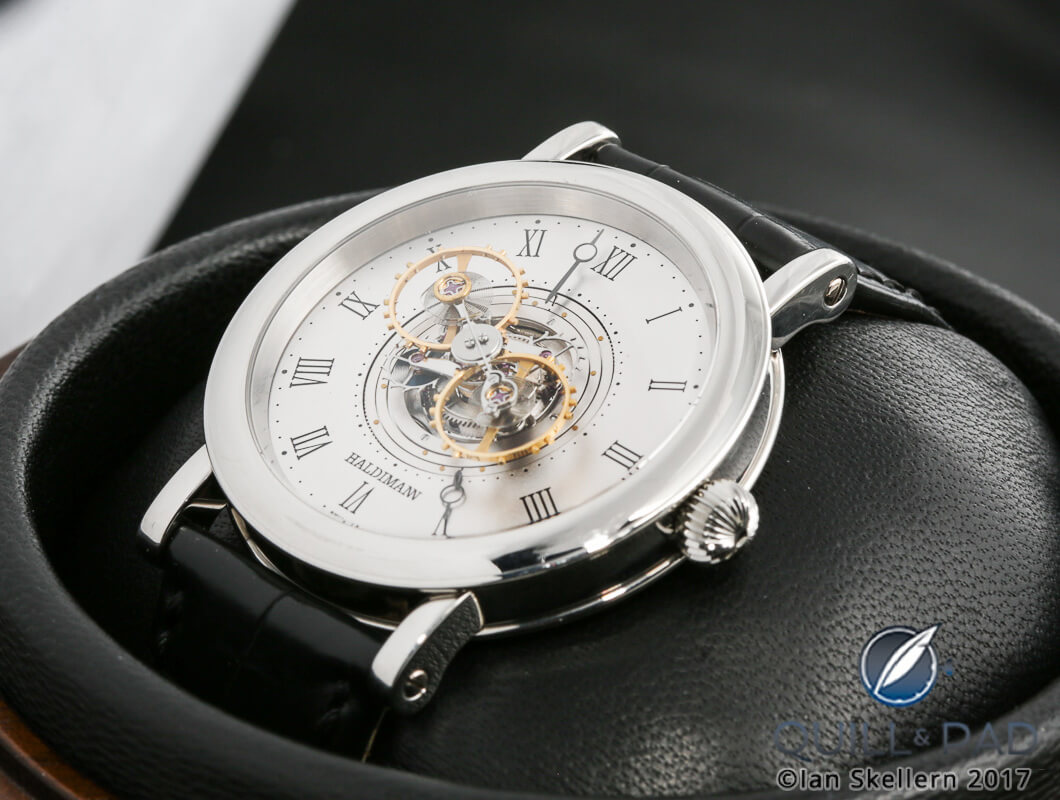
Beat Haldimann H2 Flying Resonance
Still, the Haldimann H2 follows Breguet closely and requires a rigid connection and very precise adjustment of both balances to within five seconds per day of each other. It does provide a bit more resistance to shocks (since the hairsprings are directly tied together), but ultimately is also tricky to set up due to its high constraints.
Odd goose to the odd duck: Armin Strom Mirrored Force Resonance
Armin Strom decided to go back to the drawing board and learn from the master – Breguet – when the brand’s engineers developed the Mirror Force Resonance mechanism, which was introduced in 2016.
If you remember, Breguet found that a flexible frame connecting the two pendulums provided a wide tolerance range that would allow for synchronization, demonstrating a significant benefit in making synchronization easier. But the problems Breguet had with a pendulum that needed more structure negated the wide tolerance range. Armin Strom aimed to get the best of both worlds.
Coming back to what Justin Koullapis discussed in his article, there are two main ways a set of oscillators can be coupled: a strong couple or a weak couple. The Journe and Haldimann watches are examples of weak coupling because the supporting structures are very rigid and therefore weakly transmit vibrational energy between the two balance wheels. Just like the original Breguet pendulums on a rigid frame, the energy transfer is small.
The Armin Strom Mirrored Force Resonance has a strong coupling and acts like the flexible, lightweight frame of the more forgiving Breguet pendulums. This can all be credited to the brand’s Resonance Clutch Spring.
The patented Resonance Clutch Spring is a complex, symmetrical spring mounted to the main plate at two locations and attached along its length to both balance wheels’ hairspring studs, which are both mounted in and float on the Resonance Clutch Spring. It is extremely flexible and provides virtually instantaneous feedback between the two oscillators.
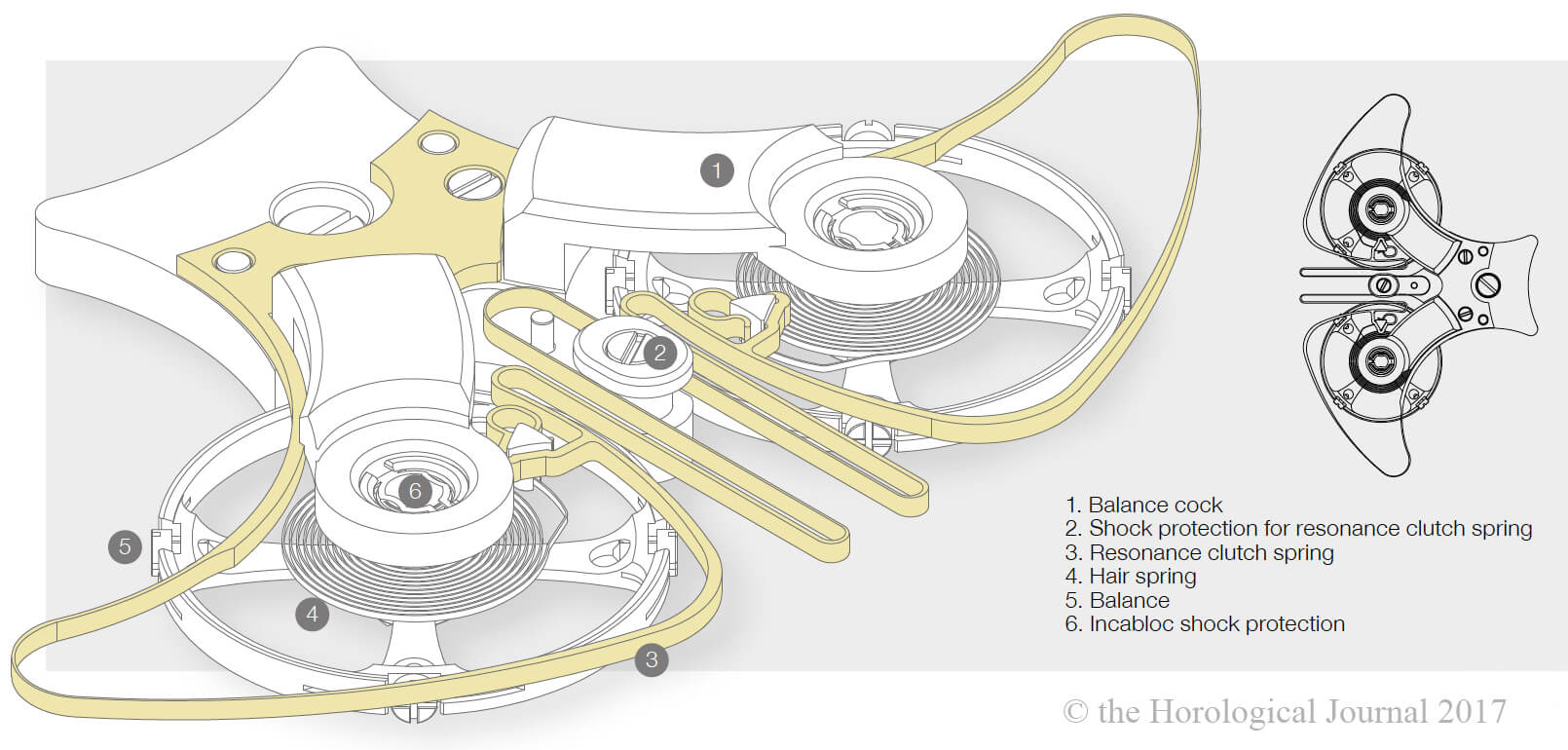
Armin Strom Resonance Clutch Spring
The flexibility of the Resonance Clutch Spring allows for more vibrational energy to be directly transferred between the two oscillators to influence the opposites rate and therefore is a strong coupling. Yet, unlike the Breguet examples, the ultimate goal of the Mirrored Force Resonance isn’t extreme momentary precision but increased long-term consistency, so the susceptibility to disturbances is less crucial over the short term.
Armin Strom Resonance Clutch Spring: small difference makes a big difference
This might be what trips up many WIS when discussing resonance and the oft-repeated claims that the Armin Strom is “cheating” to achieve its resonance. It is not; it just changed the goal for the mechanism, taking something that was a flaw for Breguet and making it a feature for Caliber ARF15.
It basically comes down to two schools of thought: accuracy versus consistency.
The balance wheels in the Mirrored Force Resonance are mounted as rigidly as any other modern balance wheels, making the structure precise and able to achieve fine adjustment just like any other accurate timekeeper. As I mentioned earlier, being forgiving to shocks and being able to move in and out of synchronization somewhat easily is not great for a precision instrument like a pendulum clock or marine chronometer, which is needed at a moment’s notice for precise measurements. Especially if the structure doesn’t support the mechanism’s ability to be finely adjusted.
But if you are designing a timekeeping device that is meant to provide predictable long-term rate averages, as well as making setup and adjustment easier, then a strong coupling of only the hairspring is the way to go.
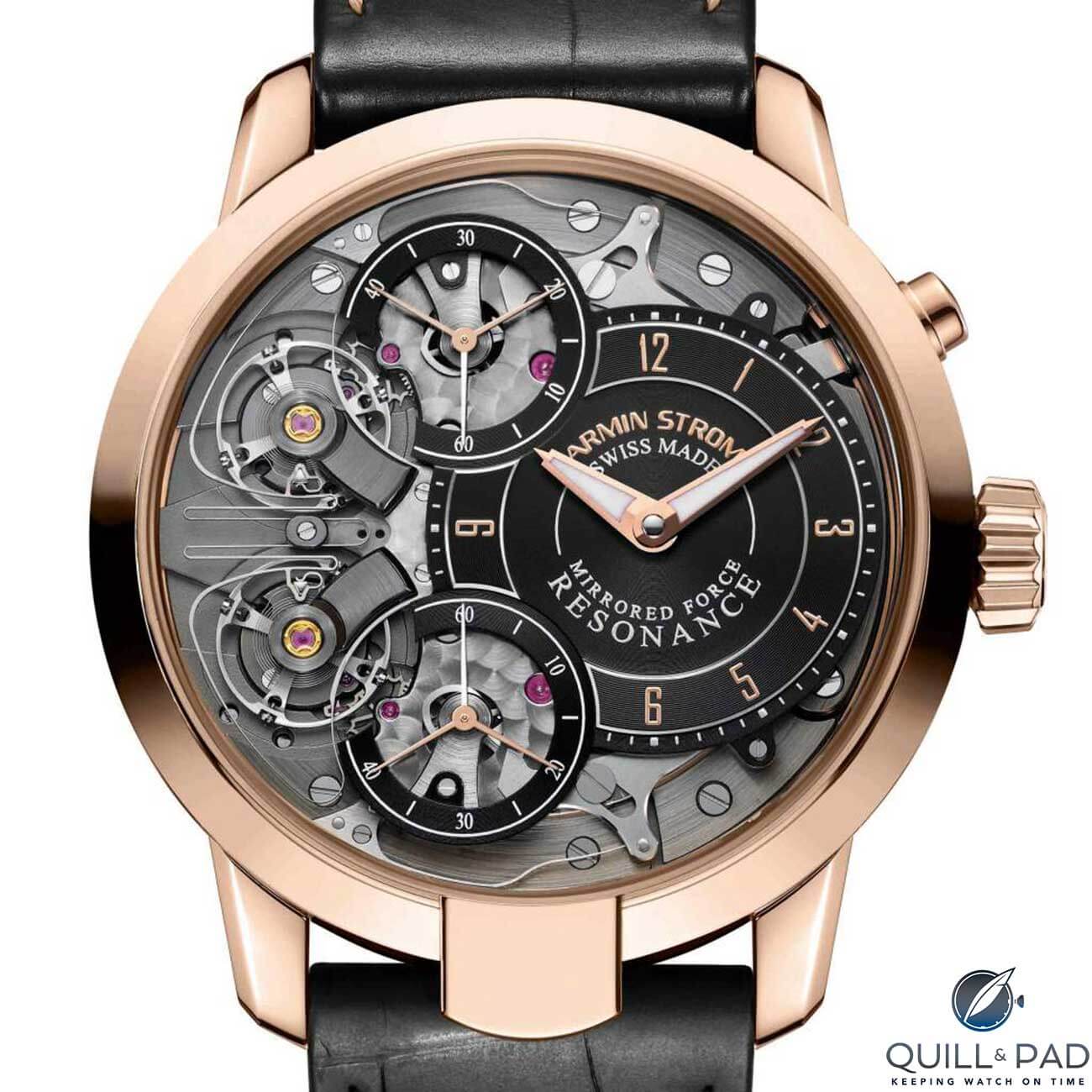
Armin Strom Mirrored Force Resonance Fire
The principle of resonance is on full display and utilizes a strongly coupled mechanism allowing for deviations in rate of up to 250 seconds (just over four minutes) before falling permanently out of synchronization. And while it may take a while to re-synchronize, quick response isn’t the goal; direct response via an easy to understand connection is top priority here.
Breguet needed structural stability for the pendulum support; the Armin Strom has this. But a pendulum can’t isolate the rate adjustment as it is fundamental to the construction of the mechanism.
Isolating the hairspring spring on a wristwatch is a much easier task and sidesteps the original problems Breguet had. It should be mentioned that the incredibly precise design of the Resonance Clutch Spring could not have been achieved before modern manufacturing methods, which utilize micron-level tolerances from wire EDM (wire spark erosion) to shape a spring that has a variety of features in one body, each performing different roles.
Combining CAD (computer-aided design) and FEA (finite element analysis) to dial in the static and dynamic stresses on the spring and then adjust it so that the energy transfer works exactly as intended would have been impossible with the tools and materials available at the beginning of the nineteenth century.
If Breguet had access to such tools in his workshop, it is quite likely he would have experimented with such a solution 200 years ago since it was clear he understood energy dynamics on a very fundamental level. He was a brilliant inventor and the only thing holding him back was the technology of the time.
He wouldn’t have done experiments finding the extreme mechanical limits of a mechanism without pursuing it further with other technologies.
It’s the same as saying Breguet would definitely have used CNC machines to make better watches if he had had access to the technology. The WIS out there can try to argue that, but any tool maker or instrument maker knows that you use the best tools at your disposal to increase accuracy and repeated consistency.
The minds at Armin Strom simply revisited the concepts that Breguet experimented with, applied new technologies, and discovered/invented new solutions.
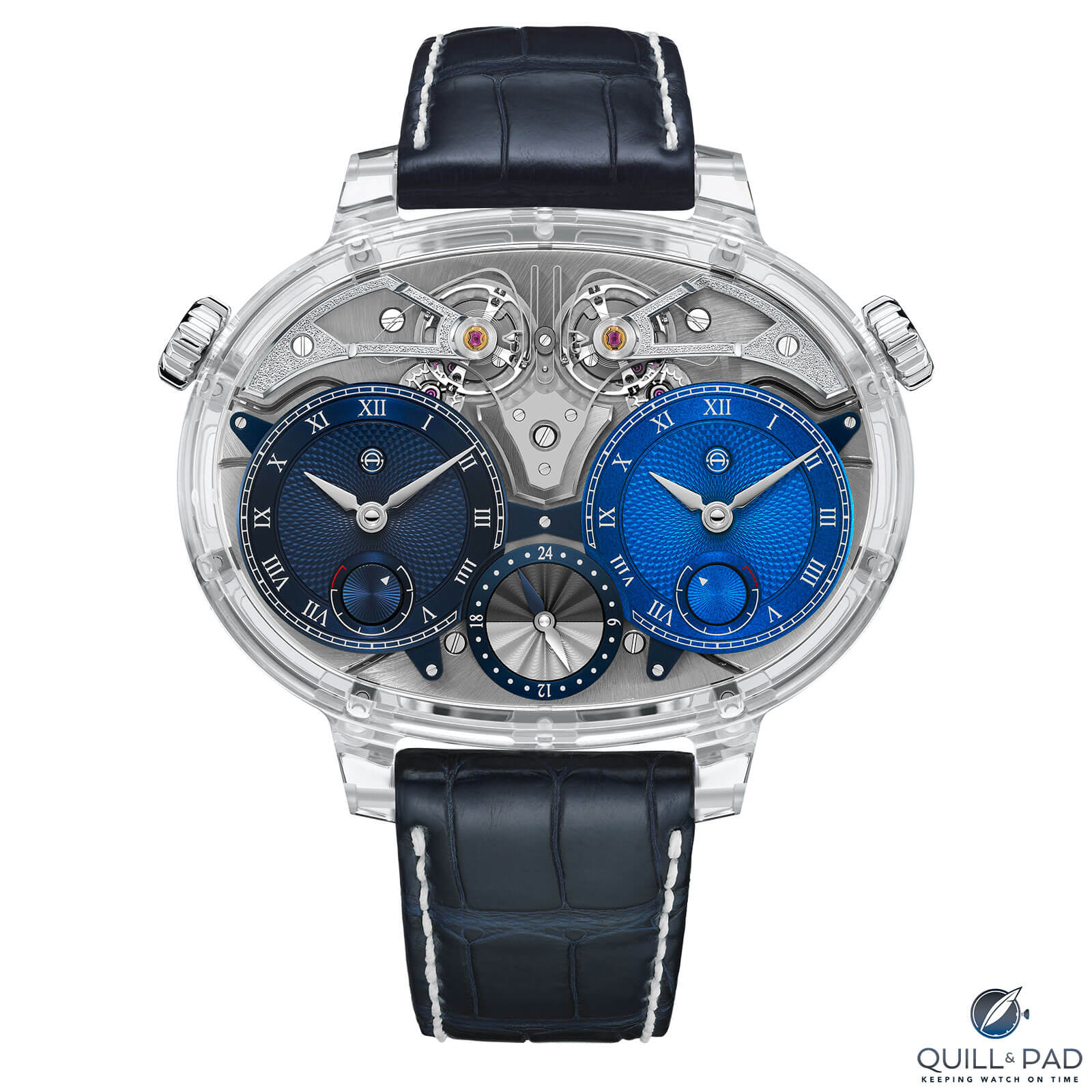
Armin Strom Dual Time Resonance Sapphire
Resonance is often touted as an incredible feat of watchmaking, which it most certainly is. But based on how watchmakers favor tradition and follow in the footsteps of the greats, it may have been arbitrarily limited in our minds to a very narrow definition that follows too closely the solution Breguet finally settled on.
The path of history would likely be different if Breguet had had modern tools at his disposal, so it’s not surprising that the Mirrored Force Resonance took a different approach because we live in a different world.
As I said: Breguet, Janvier, and others were seeking chronometric perfection. However with our current levels of precision manufacturing, we are able to venture down new paths of creative watchmaking in the twenty-first century.
If you go back and read both Justin Koullapis’ and my breakdowns of resonance, and listen to Armin Strom co-founder and technical director Claude Greisler discuss resonance with Michael J. Biercuk, professor of quantum physics and technology at the University of Sydney, you will hopefully understand the phenomenon of resonance on a much more technical and mechanical level.
The Armin Strom Mirrored Force Resonance is not only is an awesome implementation of the phenomenon, it’s a natural progression of the early research that watchmaking’s patron saint Abraham-Louis Breguet began all those years ago.
Conclusions
These three watches showcase three approaches to making a resonant wristwatch, and each of the three have their pros and cons.
The F.P. Journe Chronomètre à Résonance is the most traditional of the bunch, as Journe tends to be, and is the closest to Breguet’s original design. While it may be tricky to set up for a watchmaker and be more susceptible to shocks, it is precise and still stands tall as the first production resonance wristwatch.
Beat Haldimann’s H2 Flying Resonance is a wonderful expansion on the concept by making the resonant oscillators the entire focus of the watch. Haldimann is an expert at creating gorgeous watches; and while the H2 also requires very precise adjustment to work as well, the connection between the hairspring studs is a valuable evolution of Breguet’s original design.
The young pup, the Armin Strom Mirrored Force Resonance, represents the next steps in modern methods applied to classic problems. It is much more resilient to shocks and easier to set up, but it does rely on high-tech manufacturing processes that are the opposite of what we know as tradition, so the modern avant-garde nature of the watch puts it on different footing.
One thing is for sure: they are all great watches for watch nerds.
For more information, please visit:
www.arminstrom.com/en/collection
www.haldimann.swiss/en/Collection/Haldimann-H2—Flying-Resonance
www.fpjourne.com/en/collection/souveraine-collection/chronometre-resonance
You may also enjoy:
A Synchronistic Technical Tour De Force: Armin Strom’s Mirrored Force Resonance
Leave a Reply
Want to join the discussion?Feel free to contribute!





















































‘This might be what trips up many WIS when discussing resonance and the oft-repeated claims that the Armin Strom is “cheating” to achieve its resonance.’
Imagine thinking that. *tugs collar*
This reads like a puff piece for Armin Strom. AS’ design actually derives from a more primitive version of resonance clocks made by Janvier, until he and Breguet mastered the effect. People can more clearly understand this by watching the presentation given by F.P.Journe and Osama Sendi at the Horological Society of New York: https://hs-ny.org/meetings/2020/3/2/the-phenomenon-of-resonance-by-francois-paul-journe-and-osama-sendi
Said like a true Journe fan (and I count myself among them). I’m curious as to why you think Armin Strom’s approach to resonance is like a Janvier’s method as I would have thought that Journe’s system more closely follows on from Janvier and Breguet’s resonant clocks.
Regards, Ian
Please enjoy the HSNY presentation and I think it will answer everything as the progression of Janvier’s resonance work is traced from preliminary to more advanced application.
Oh, and I should say that Journe’s work is like Janvier’s and A.L.Breguet mature and advanced applications of resonance. As I said, Armin Strom had to rely on a more primitive version.
Armin Strom didn’t have to rely on anything. They looked at what had been done in the past and looked at how they could do better. I do think Journe’s Resonance is a more wearable, classical-looking watch and would love to own one, but the fact is that it falls out of resonance relativity easily compared to Armin Strom’s resonance watches. And if the principle goal is to improve the accuracy of a wristwatch by using two resonant oscillators (and that’s not a given), then it seems to me that the more time the oscillators are in resonance the better.
Regards, Ian
Dear Spangles, thank you very much for your feedback and your comments. We would not say that we rely on a more primitive version. In fact we did a lot of research to understand the phenomenon of Resonance in order we can take the most of advantage out of it. In our video “Let’s talk about Resonance” we go a bit more into the detail, we invite you to watch the video on our YouTube chanel: https://www.youtube.com/watch?v=p4PS01XYpp4&t=33s
Best regards from the manufacture
I did watch (and enjoy, thank you) the presentation before asking you to elaborate as I didn’t think the presentation supported your statement. But I’m not a watchmaker or physicist and don’t imagine that I understand it all.
Regards, Ian
Thanks for the input, that was indeed a great lecture! With this article I specifically set out to explain why they are all interesting applications of the phenomenon yet none are inherently better than the other, they are just different ways of achieving the effect. Breguet and Janvier did indeed master the effect given their technical capabilities of the time, and within a set of goals aiming for chronometric precision. If you change the goals, the methods for achieving the effect can and likely will change. There is not one specific way to do it, and one cannot be deemed to be better than another IF there is a different goal in mind. That is why what the Armin Strom seeks to accomplish is different, a resonant system that can be easily drawn to the resonance frequency.
This is why I pointed out how Breguet discussed that a flexible coupling provided much better and easier to tune resonance window, though had flaws in the specific application for rate stability. To call the Armin Strom primitive is to discount all of modern technology in hopes of deifying Breguet, Janvier, and I guess Journe. Journe has always been somewhat of a traditionalist, so of course he would pursue a direction that was classically inspired. This doesn’t mean his method is “more advanced” simply because someone 200 years ago decided on that direction. In fact, technically, and mathematically, the original Breguet method is WAY more basic than how the Armin Strom functions, it relies on the weakest and least controllable method to induce resonance.
Armin Strom took an old idea that was already debateably useful and tried a different method for creating it, a method only possible with modern technology. Let’s understand that resonance watches are not actually the holy grail of chronometry, otherwise they would have been much more common over the preceding centuries. It’s a niche phenomenon that is very technical, and if people make new attempts to create one, then we are all the better for it existing.